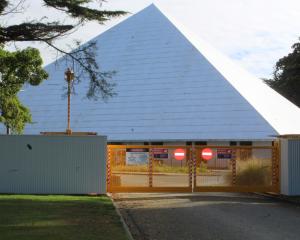They may be regarded as an unwelcome weed around Queenstown but at Maori Point, near Tarras, a good use has been found for Douglas fir trees.
A team of 14 men wielding chainsaws is turning 67 tonnes of Douglas fir into a log house.
The man behind the project is Wanaka Senior Constable Sean Hurley, who is an enthusiast for a style of house construction used for centuries in Europe and popularised in New Zealand through American Western movies.
As well as liking the ''tactile'' wood finish, Mr Hurley says log houses are much warmer than many conventional houses.
''When you've got 15 inches of wood you have got a considerable amount of R-value [thermal insulation].''
Mr Hurley said log houses were ''marginally'' more expensive to build than conventional houses, and that was partly due to the price of logs being ''fairly high'' at present.
However, it was possible to reduce costs by pooling resources and employing a fair amount of DIY.
Mr Hurley bought 85 logs from a forest in the Blue Mountains, near Tapanui, and his first job was to peel off all the bark by hand - at the rate of no more than two logs per day.
End to end, the logs would stretch a kilometre.
For the construction phase, American expert Robert Chambers has taken over, guiding a group of men from New Zealand, Australia, America, Germany and Switzerland learning log-building skills so they can apply them to their own projects.
''Log homes just seem to be a dream for a lot of people,'' Mr Chambers said.
''I think a bit of it is the Old West, the Daniel Boone kind of thing.''
Mr Chambers, who once owned a log house building company but now runs annual courses in New Zealand and Alaska, says he is not a fan of a good deal of residential house design.
''To me it looks a bit like they are motel units.''
He believes life in a log house has a ''different feeling''.
''I feel more relaxed, more secure, quieter. Surrounded by all that timber, the beautiful colours, the honey colour, all those sensations make it a great experience.''
Mr Chambers says log house building has made considerable advances in the past 30 years. There is more control over how logs go together, how much cracking occurs in the timber and how the building settles.
Once the logs had been shaped by chainsaw and fitted together to form the walls, a 125sq m concrete slab would be poured nearby.
The walls would be shifted on to the slab, log by log, and holes drilled for electricity cables and for metal anchoring rods.
While working on his plans, Mr Hurley discovered about 50 log houses of various types and designs around Wanaka.
He hopes to have the whole build, which includes a conventional component, completed in two years.
His house is in a radiata pine forest. He says radiata pine is good only for shelter, shade or firewood.










